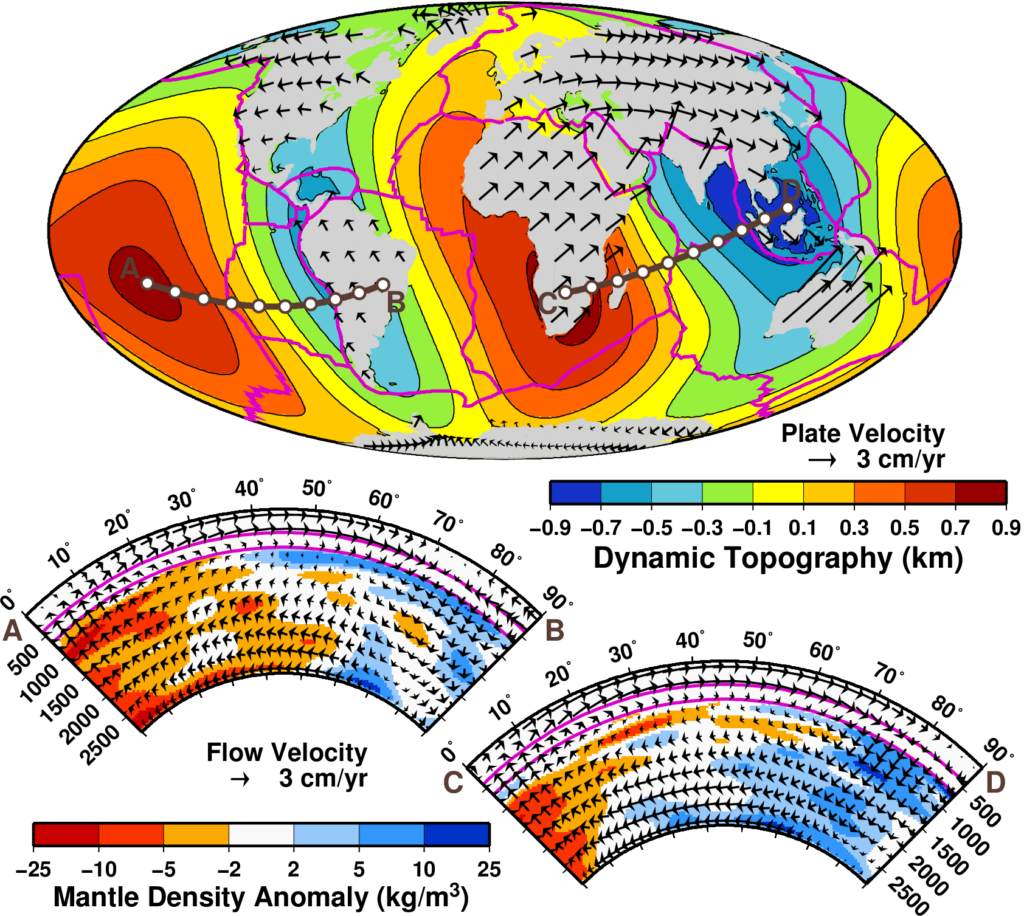Task 6: Analyzing the mismatch between observed and modelled dynamic topography
Convection within Earth’s mantle supports deflections of Earth’s solid surface and core-mantle boundary (CMB). These deflections, known as dynamic topography, are difficult to observe directly because they are obscured by larger-amplitude isostatic topography associated with crustal density variations. Over millions of years, temporal variations in dynamic topography affect sea level and continental dynamics. Dynamic topography is also important for understanding sea level change since the last major deglaciation at ~120 ka.
Despite its importance, our understanding of dynamic topography is complicated by significant uncertainties about its amplitude, particularly for the longest wavelengths (~104 km or larger). Observational studies, which estimate “residual” topography by removing models for isostatic topography from Earth’s observed topography, suggest amplitudes of only a few hundred meters for the longest-wavelengths. These estimates of residual topography contrast strongly with predictions of dynamic topography from mantle flow models, which suggest long-wavelength amplitudes larger than 1000 m (e.g., figure below).
We propose to use constraints on density, composition, and viscosity from other aspects of this 4D Dynamic Earth effort to develop estimates of residual topography and model predictions of dynamic topography. Our work will focus on including lateral variations in viscosity and/or density structure within the models. In particular, we note that recent conceptual models suggest that large compositional variations may be present within the lower mantle, associated
with the Large Low Shear Velocity Provinces [LLSVPs, Garnero et al., 2016] or BridgmaniteEnriched Ancient Mantle Structures [BEAMS, Ballmer et al., 2017].
These compositional structures may be associated with large lateral variations in both density and viscosity [e.g., Heyn et al., 2018; Gülcher et al., 2021]. These lateral variations may significantly affect our estimates of observed residual topography and/or predicted dynamic topography. If these lateral variations help to resolve the amplitude discrepancy, then dynamic topography may help to place an important new constraint on the dynamics of the lower mantle.
We plan to investigate three possible explanations for the amplitude discrepancy, as described in the WP 6100, WP 6200 and 6300.

To understand this discrepancy, the team from the University of Oslo will use constraints on density, composition, and viscosity from other aspects of this 4D Dynamic Earth effort to develop improved estimates of residual topography and new model predictions of dynamic topography (e.g., akin to the model shown in the left). Their work will focus on including lateral variations in viscosity and/or density structure within the models.
Workpackages Task 6
It is not known how lateral variations in viscosity may affect the admittance. We plan to develop mantle flow models that include lateral variations in viscosity and that predict both gravity and dynamic topography. We can use such models to estimate the appropriate admittance for different Earth density models, which will enable us to convert observed gravity anomalies into predictions of “observed” residual topography.
We plan to develop numerical models for present-day mantle flow that incorporate density heterogeneity associated with compositional variations. By comparing the dynamic topography predicted by such models to observed dynamic topography (e.g., from WP 1000), we plan to develop new useful constraints on the density structure of the lower mantle.
Only a few models have probed the influence of lateral viscosity variations on dynamic topography. A few studies have looked at the effect of lateral viscosity variations within the upper mantle on global mantle flow [Čadek and Fleitout, 2003; Kaban et al., 2007; Yang and Gurnis, 2016], and these studies found only a small impact of lateral viscosity variations on the geoid and dynamic topography, especially for long wavelengths.
We expect large lateral viscosity variations associated with both LLSVPs [e.g., Heyn et al., 2018] and BEAMS [Ballmer et al., 2017]. It is not known how such viscosity variations may affect predictions of dynamic topography. We plan to expand on the numerical models developed as part of WP 1000 and WP 2000 to investigate the impact of lateral viscosity variations on dynamic topography, and compare predictions of dynamic topography to constraints on residual topography (e.g., from WP 1000). As for WP 2000, this comparison will help us to constrain lower mantle dynamics.